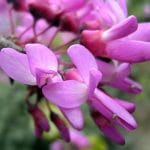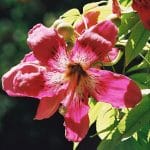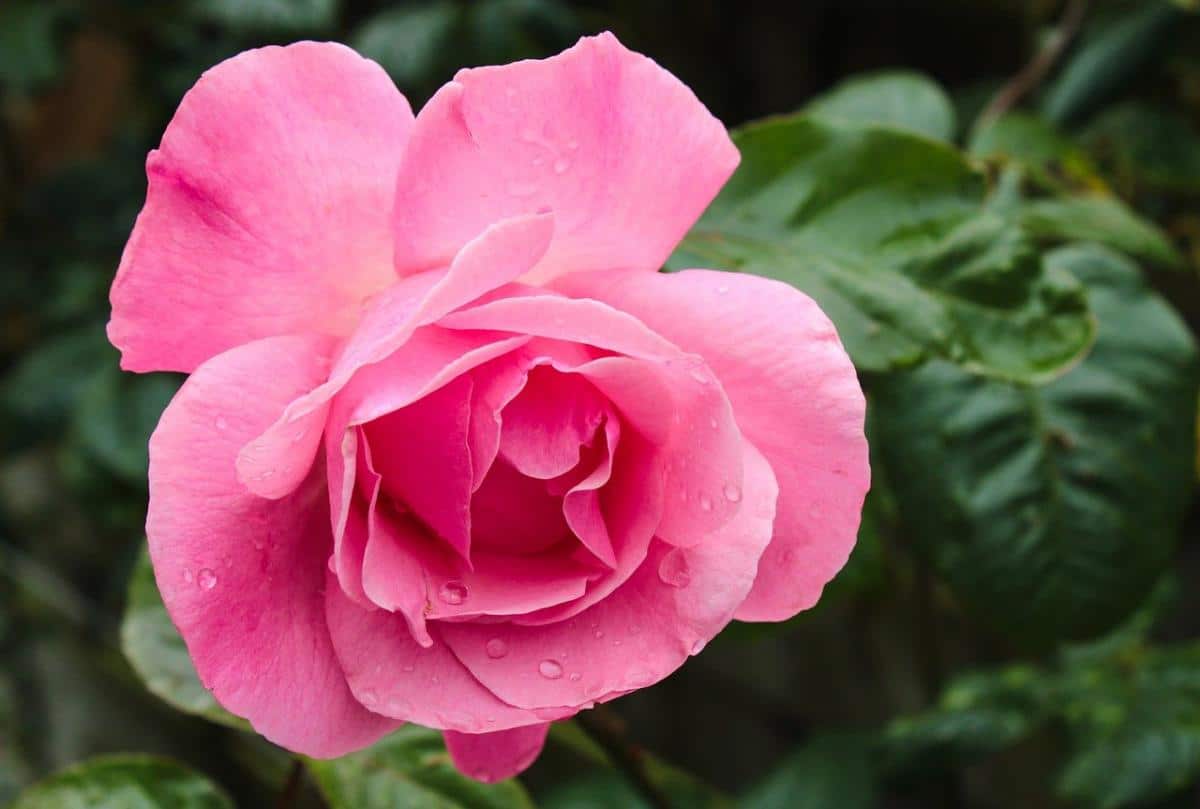
Pink is a color that you always like to have in a garden or on a terrace. By associating yourself with very positive things, such as kindness, empathy and generosity, it is easy for plants that produce flowers of that hue to enchant us.
Fortunately, there are many species of plants that give pink flowers: trees, shrubs, herbaceous plants ... Knowing their names will only take a moment, although if you want to know their characteristics and care, we invite you to stay with us a little longer.
Mountain alder (Hormathophylla spinosa 'Roseum')
- Image - Wikimedia / Ghislain118 (AD)
- Image - Wikimedia / Ghislain118
Formerly known as alyssum spinosum, is a perennial herbaceous plant that forms mounds up to 30 centimeters high. Its branches are thorny and small, grayish-green leaves emerge from them. In early summer it produces flowers grouped in clusters and they are pink.
If you live in an area where there are often droughts, this plant with pink flowers is ideal for you. Put it in a sunny area, in a well-drained soil, and give it sporadic watering. Supports up to -7ºC.
Tree of loveCercis siliquastrum)
- Image - Wikimedia / Zeynel Cebeci
- Image - Wikimedia / Kousvet
El love tree, also known as mad carob tree, is a deciduous tree with a trunk that tends to lean a little over the years and that reaches up to 6 meters high. Its crown branches a lot, so it is an ideal plant to provide shade. Its leaves, rounded and light green on the upper side and glaucous on the underside, appear after the flowers. These flowers are pinkish-lilac, and bloom in spring.
It grows in sunny places, in rich, well-drained soils. It is not a demanding plant. It is somewhat resistant to drought, and it is not harmed by frosts down to -18ºC.
Azalea (Rhododendron simsii o rhododendron japonica)
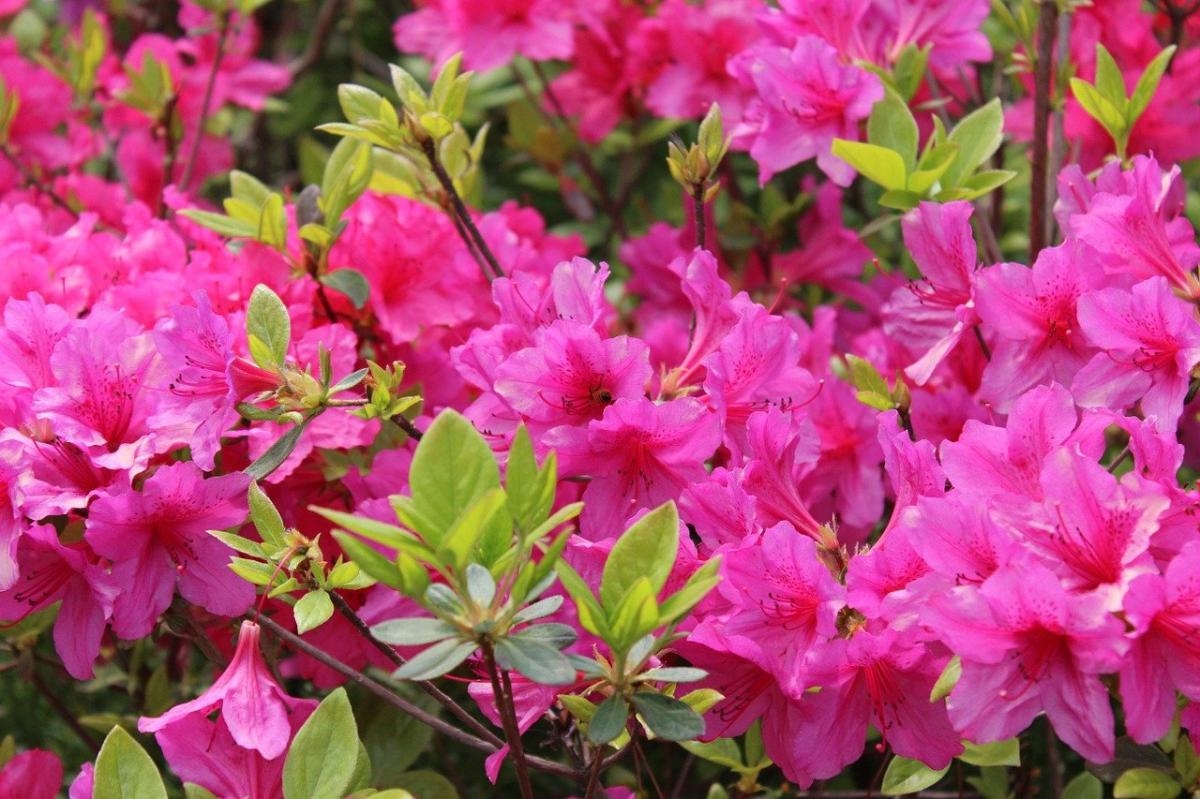
Azaleas are shrubs native to Asia that They reach a height of approximately 1 meter. They are generally deciduous, losing their leaves in winter, but depends on the variety. They bloom during the spring. These flowers measure about 3 centimeters in diameter, and can be white, red, or pink (more or less clear).
They are acidic plants, so it is important that they are planted in soils with a low pH, and that they are also irrigated with rainwater or with one that is drinkable.
Carnation (Dianthus caryophyllus)
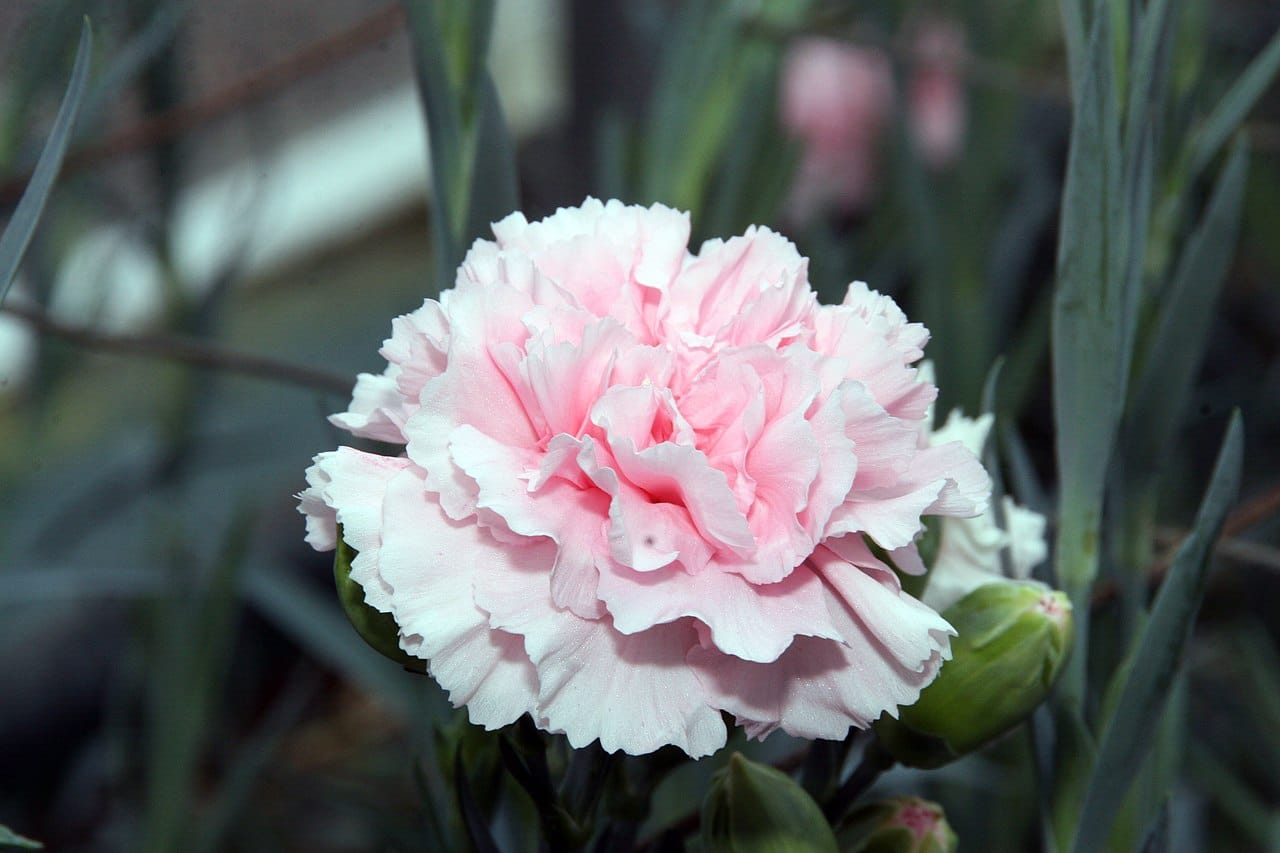
Image - Wikimedia / David J. Stang
El clavel It is a perennial herbaceous plant native to the Mediterranean region that It can reach more or less 1 meter in height, although there are smaller varieties. Its flowers appear throughout the spring and summer, and they do so from a floral stem which emerges from the center of the plant. These flowers can be many different colors: white, red, hot pink, soft pink (like the flower in the image above), red, or even bicolor.
So that you can enjoy them, you have to put the carnation in a sunny place so that it can develop well, vertically. Likewise, it is important that you give it moderate watering so that your pink carnation flower can show off.
Curly rockrose (cistus crispus)
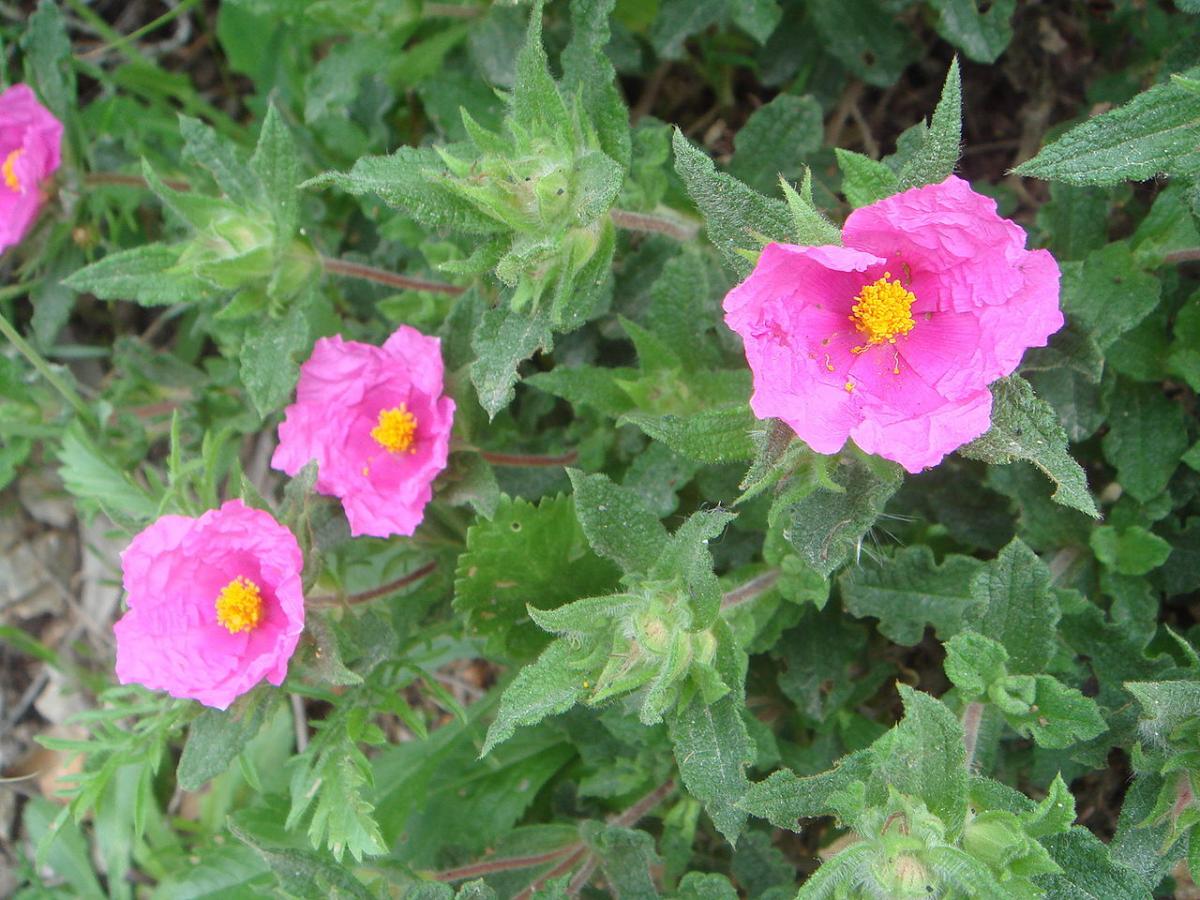
Image - Wikimedia / Xemenendura
La curly rockrose is a perennial herbaceous plant that reaches 50 centimeters in height. It has small leaves, densely covered by short whitish "hairs", and pink flowers that appear either singly or in clusters during spring.
It is very easy to care for, since it is a species that can withstand summer droughts as long as it has been in the ground for at least a year. It is also ideal to have in pots with substrates that drain water quickly, such as a mixture of peat with 50% perlite.
If there is something negative that we have to say about her, it is that she fears waterlogging. But it is not harmed by moderate frosts (down to -7ºC).
Pink mauve (lavatera trimestris)

Image - Wikimedia / Kor! An (Корзун Андрей)
The pink mallow is an annual herb whose life expectancy is very short, less than twelve months. The seeds germinate in spring, their flowers sprout in summer and when the seeds mature they begin to wilt to death in autumn / early winter. Even so, it is very interesting to save these seeds every spring, since the normal thing is that they all sprout quickly. What's more, reaches a height of 120 centimeters, and it produces pink flowers about 4 centimeters in diameter, which makes it very, very pretty.
Plant it in a sunny place, either in the garden or in a pot. Water it often but avoid waterlogging. It is also advisable to fertilize it from time to time during flowering, especially if it is kept in a container, with fertilizers for flowering plants.
Drunk stick (ceiba speciosa)
- Image - Wikimedia / Dick Culbert
- Image - Flickr / mauro halpern
La ceiba speciosa (before Chorisia speciosa) is an imposing deciduous tree. Reaches a height of 25 meters or more, and its trunk in the shape of a bottle can measure up to 2 meters in diameter. This is usually covered with thick conical spines, and has a rather branched crown. During spring, and if the weather allows it also in summer, it blooms producing flowers with pink petals.
In countries like Spain it is grown a lot in gardens, but it needs a lot of space to be able to develop normally. Likewise, it is important that the sun shines directly, and that the soil drains the water well. Resists up to -7ºC.
Genus Prunus
Prunus are deciduous trees that can reach a height of about 10 meters on average. Many species are cultivated in orchards as they produce edible fruits, such as the almond tree (Almond), plum (Prunus domestica), or the cherry tree (Prunus avium). But there are many others that are held for their beautiful pink flowers, like these:
Prunus glandulosa 'Roseo Plena'
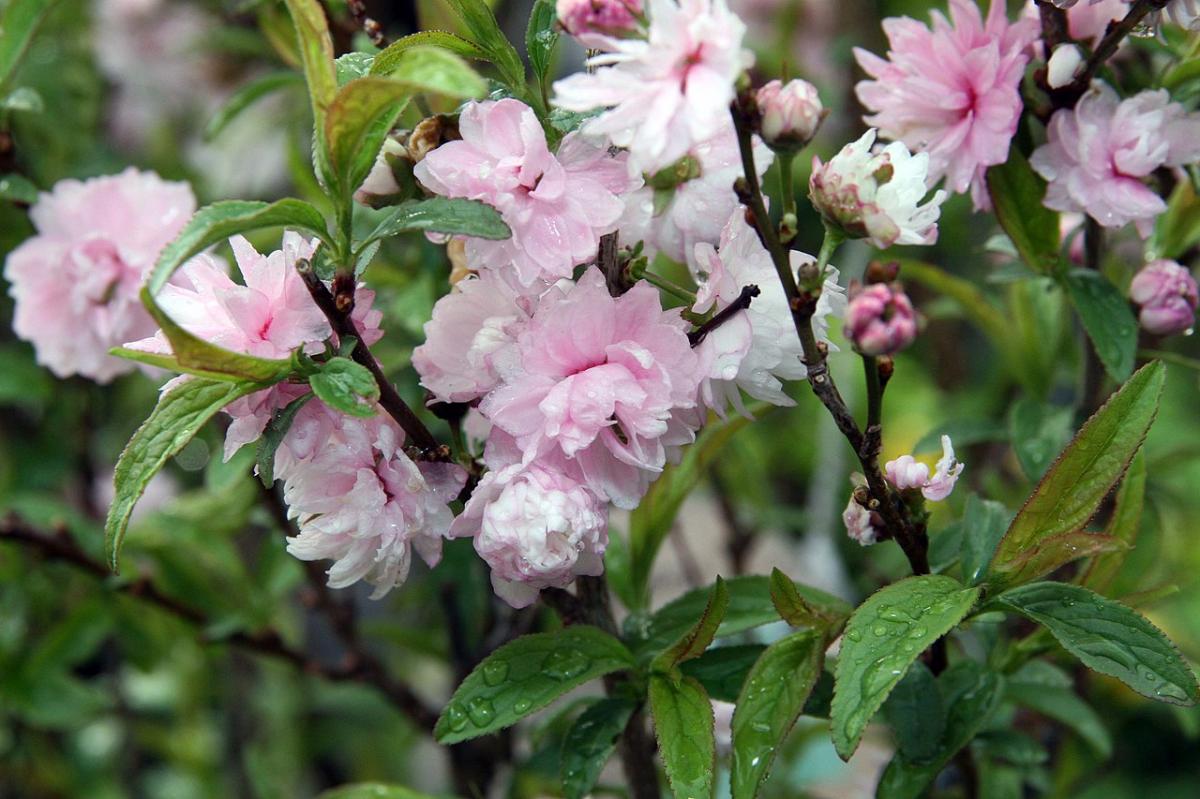
Image - Wikimedia / David J. Stang
This is a cultivar that develops as a deciduous shrub up to 1,5 meters high. Its leaves are light green and alternate, and it produces large numbers of double pink flowers in spring. It is a real gem for gardens, but also to enjoy in pots.
It grows both in the sun and in semi-shade, it tolerates drought and frosts down to -20ºC. But you should know that it can be attacked by fungi such as mildew when it is watered too much.
Prunus serrulata
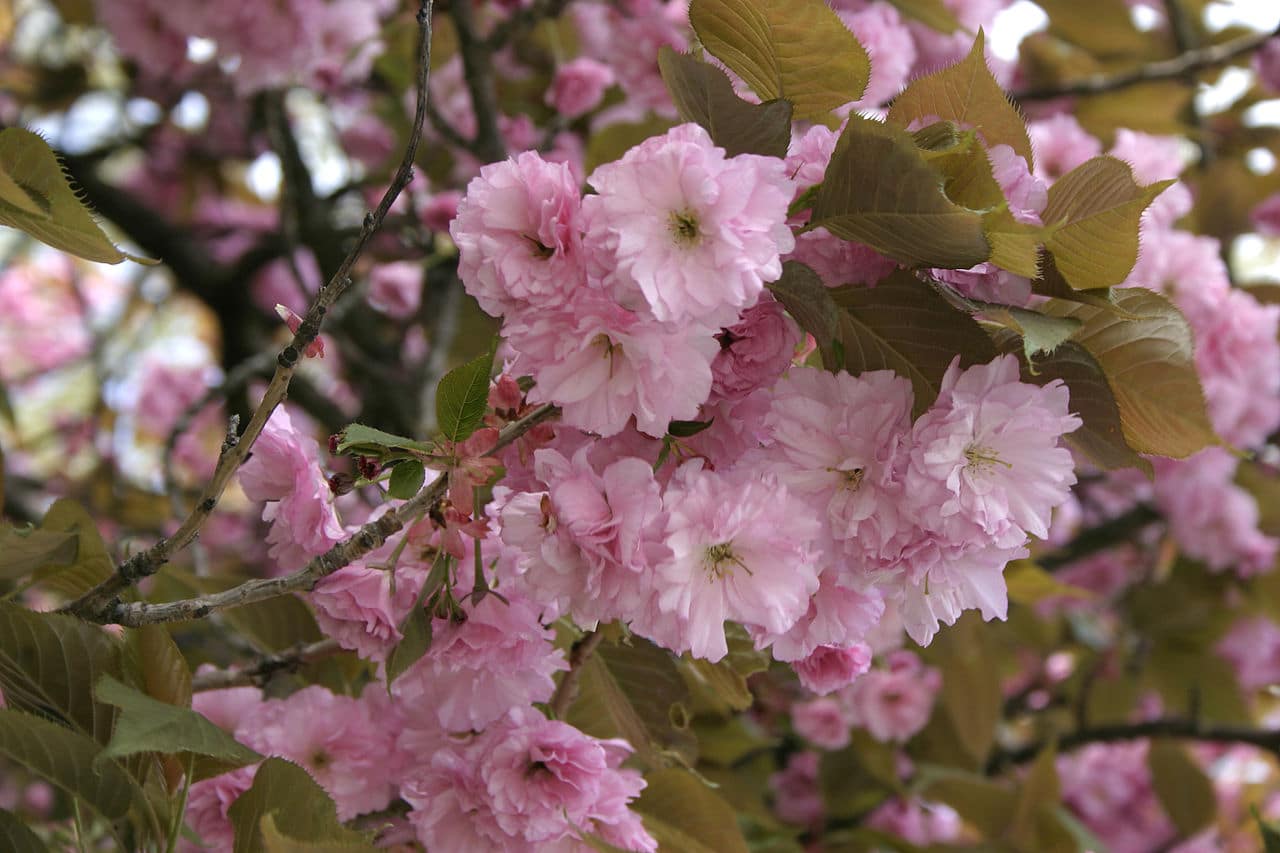
Image - Wikimedia / Nino Barbieri
El Prunus serrulata It is a deciduous tree known as the Japanese cherry or Japanese blossom cherry. Grows up to 7-9 meters, with a solitary trunk and a densely branched crown full of leaves that turn yellow, red or crimson during the fall. Its clusters of flowers sprout in spring, and can be white, or more commonly pink. If you want to play it safe, variety 'kanzan'it has them of this last color.
Due to its high ornamental value, it is a plant that is grown in all types of gardens, although it does best in temperate climates and slightly acidic soils. Water it often during the summer so it doesn't get dehydrated, and voila. Resists up to -20ºC.
Prunus x subhirtella 'Pendula Plena Rosea'
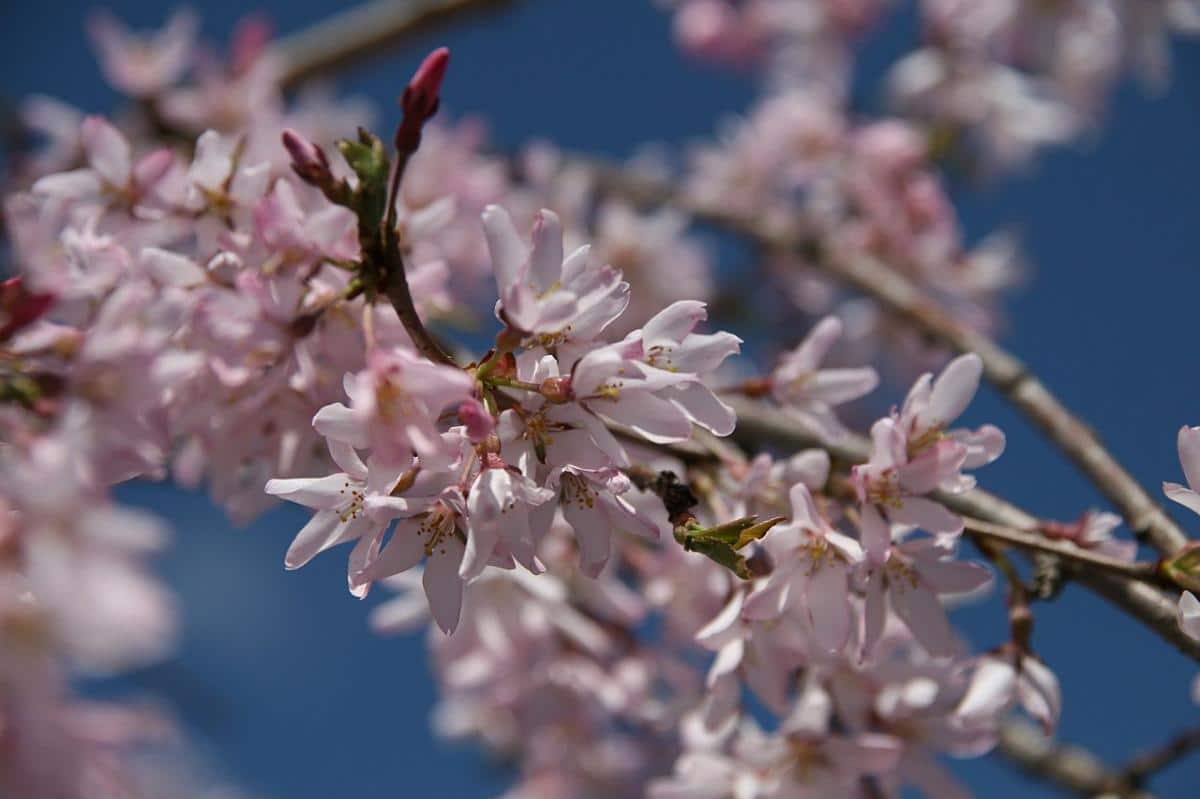
Image - Wikimedia / David J. Stang
It is a cultivar that reaches a height of 4 meters, with green leaves that turn yellow, orange or reddish in autumn. It produces its flowers in spring, shortly after it has resumed its growth after winter rest.
It tolerates many types of soils, such as sandy and calcareous; it also supports up to -26ºC without being damaged. Of course, it needs moderate watering, and mild temperatures in summer.
Hyacinth (Hyacinthus)
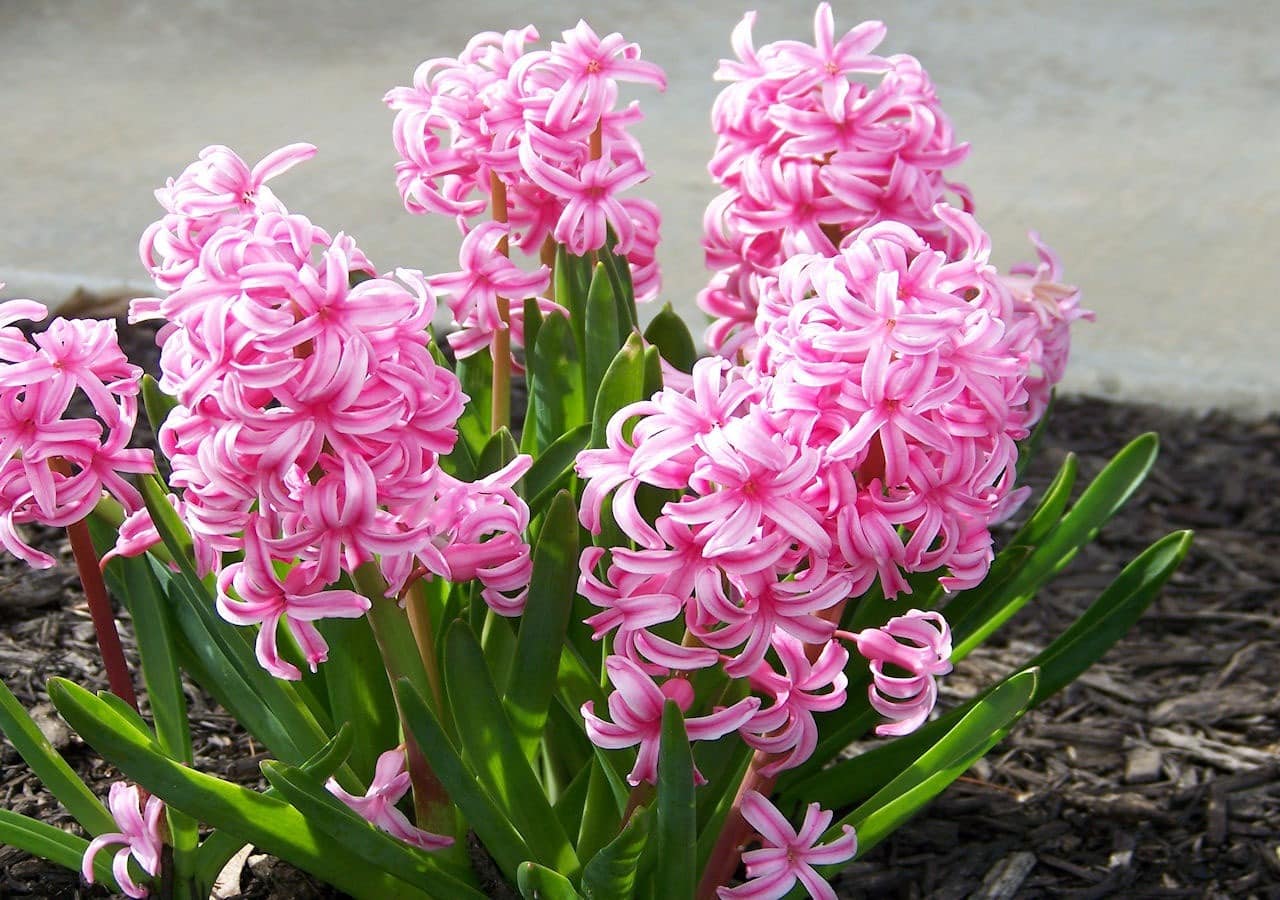
El hyacinth It is a bulbous plant native to the Mediterranean region. When it sprouts, something it does in winter-spring, it develops lanceolate green leaves that grow more or less vertically; and during the spring it blooms producing a not too long floral stem from which numerous white, blue or pink flowers sprout. The total height of the flowered plant is about 10-15 centimeters.
It is a plant that, best, is to have it outside since it needs to be exposed to direct sunlight, and also, it resists the cold. However, there are those who are encouraged to have it indoors.
Petunia (Petunia x hybrida)
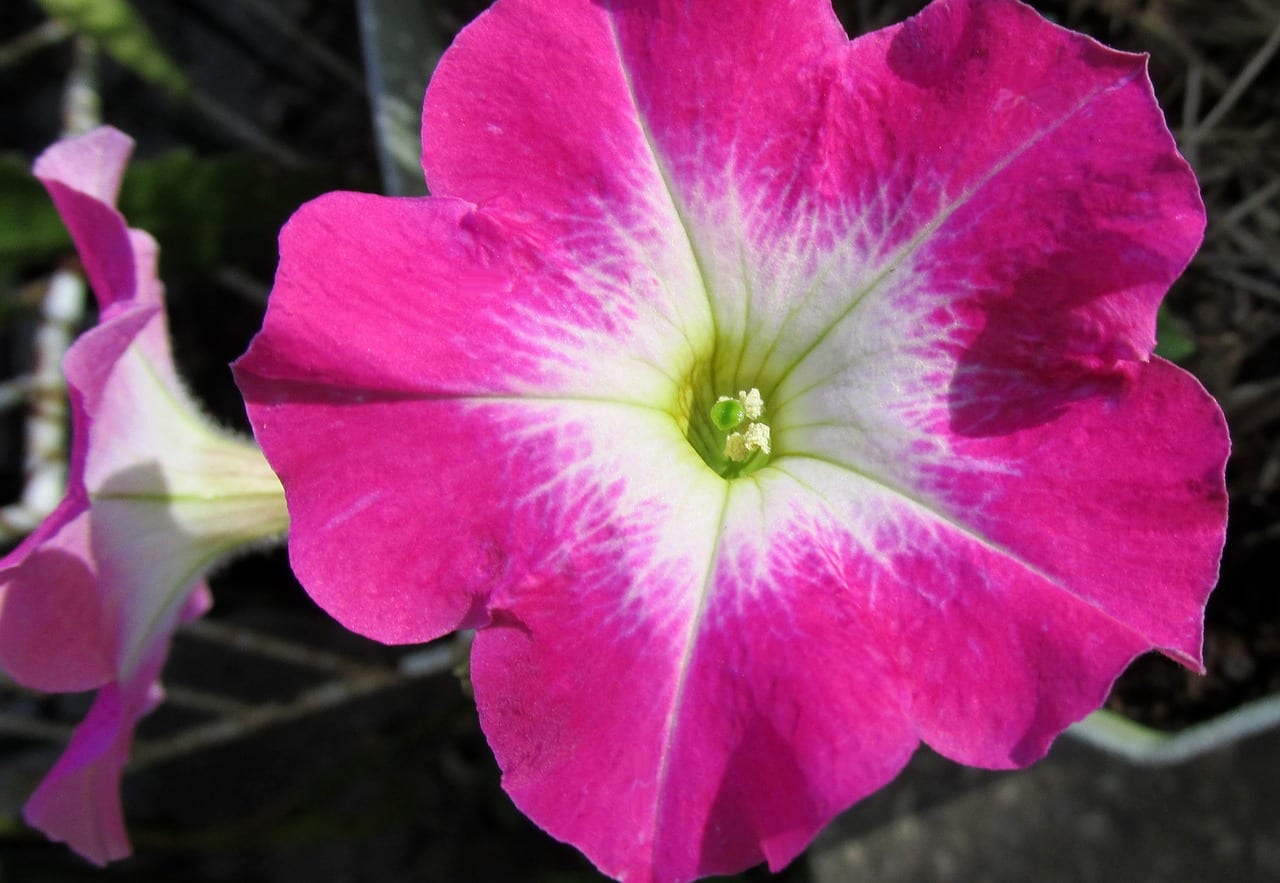
La petunia It is a herbaceous plant of low height -it does not usually exceed 20 centimeters, being the maximum 60cm- that flowers in spring. Unfortunately, it is also a herb that, in a temperate climate, is short-lived. In fact, in Spain it is usually cultivated as annual or seasonal, due to its zero resistance to cold. But it must also be said that it multiplies very well by seeds if they are sown in spring.
If we talk about flowers, they can be of different colors, such as white, red, blue and, of course, pink; there are also cultivars with multicolored flowers. So that it is beautiful, put it in a sunny place and water it when you see that the earth is drying up.
China rose (Hibiscus rosa-sinensis)

Image - Wikimedia / Forest & Kim Starr
La China rose is a deciduous shrub that can measure up to 5 meters in height, although it is usually lower (maximum 3 meters). The leaves are ovate to lanceolate, bright green in color, turning yellow in autumn before falling. The most beautiful thing it has are its flowers: these are 6-12 centimeters long, and they can be red, yellow, orange; single or double (double crown of petals). Some varieties of pink flower are the 'Pink Versicolor', and the 'Dainty Pink'.
It is a plant that must be kept in places where the climate is mild, since it does not resist moderate frosts (only up to -3ºC, and provided they are punctual). It lives both in the sun and in semi-shade, and in soils rich in organic matter.
Rose bushes (Rosa sp)

The roses are thorny shrubs that are grown in pots or gardens, and that they can grow over 1 to 2 meters, except climbers that are more than 5 meters. These plants bloom most of the year, from spring to fall in mild climates, and do not need much care. If you are looking for varieties with a pink flower, you have for example the »Ballerina» which produces small but very fragrant flowers, or the »Carefree Wonder», with semi-double dark pink flowers.
They live well whether you have them in the sun or in semi-shade, although I recommend that you put them in a place where they will get at least 4 hours of direct sunlight. In this way, they will produce more flowers. Of course, you must water them very often, since they do not resist drought. As for frosts, they support up to -7ºC.
Taray (tamarix gallica)
- Image - Wikimedia / Javier martinlo
- Image - Wikimedia / Zidat
El tamarisk It is a deciduous tree or small tree that grows between 6 and 8 meters tall. Its branches are long and flexible, almost pendulous, and although it has leaves, they are very small and scaly. During the spring, and sometimes also in summer, it is filled with pink or white flowers, which attract very beneficial insects for the garden such as bees.
It is a highly recommended species for growing in places near the sea or the coast, since it lives very well in sandy soils and tolerates well those that are a little saline. Of course, it can be grown further indoors, in well-drained soils and always in full sun. It resists drought and frost down to -7ºC.
Tulip (Tulipa sp.)
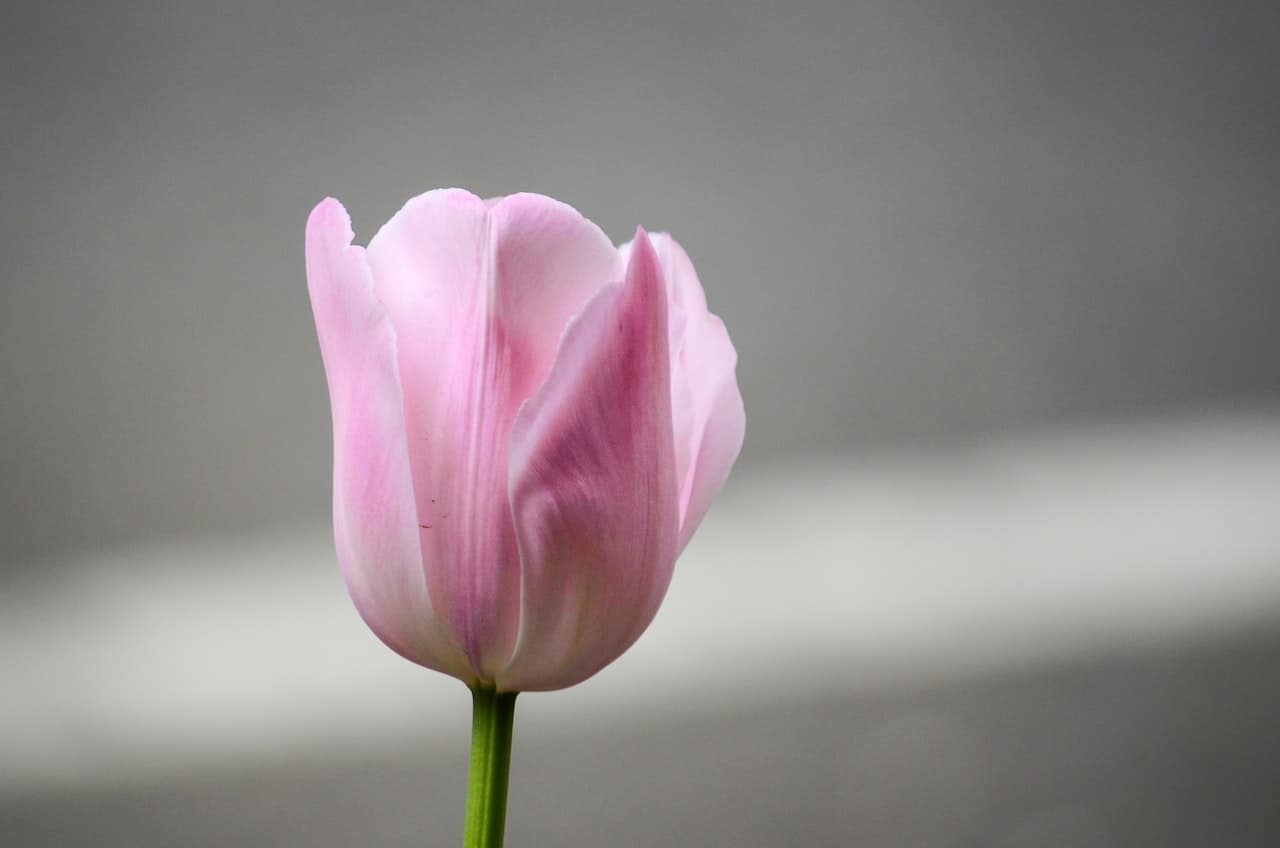
El tulip It is, like the hyacinth, a bulbous plant that blooms in winter-spring. It is native to North Africa and Asia, as well as Southern Europe. However, today more than a hundred cultivars have been obtained, which are the most commercialized (the pure species are difficult to find for sale). The leaves are green, longer than they are wide, and end in a point; and the flowers sprout from a stem which is about 10-15 centimeters high. Total, the flowering plant is approximately 15-20 centimeters tall.
It is very important that it is exposed to direct sunlight, otherwise it will not be able to flower well. In addition, you have to water it from time to time so that the earth does not dry out.
Which of these plants with pink flowers did you like the most?



